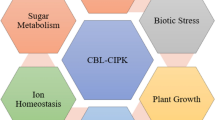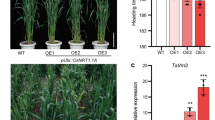Abstract
Plants, when exposed to abiotic or biotic stress, produce several pathogenesis-related proteins to counteract the effects of stress. Osmotin is one of the important pathogenesis-related proteins induced during several stress conditions. We have developed improved salt stress tolerant transgenic chilli pepper plants (Capsicum annum L. var. Aiswarya 2103) by ectopic expression of the Nicotiana tabaccum osmotin gene using Agrobacterium tumefaciens EHA105 as a vector. Four-week-old chilli pepper leaves were used as an explant and A. tumefaciens EHA105 harboring pBINASCOSM plasmid that contains osmotin gene under the control of CaMV 35S promoter and npt II as a selectable marker was used in co-cultivation. Transgene integration and expression were analyzed using molecular, immunochemical, and biochemical assays. PCR and Southern blot analysis confirmed that osmotin gene has been successfully integrated into the genome of chilli pepper plants. The osmotin gene was stably segregated and expressed in T2 generation transgenic chilli pepper plants, and it was confirmed by Western blot analysis. Biochemical assays of these putative transgenic plants revealed enhanced levels of chlorophyll, proline, glycinebetaine, APX, SOD, DHAR, MDHAR, GR, and relative water content. Yield potential of the putative transgenic chilli pepper plants was evaluated under salinity stress conditions in a green house. The putative transgenic chilli pepper plants overexpressing the osmotin gene were morphologically similar to wild-type plants and produced 3.32 kg chilli pepper fruits per plant at 300 mM NaCl concentration.






Similar content being viewed by others
Abbreviations
- CaMV 35S:
-
Cauliflower mosaic virus 35S promoter
- APX:
-
Ascorbate peroxidase
- SOD:
-
Superoxide dismutase
- DHAR:
-
Dehydro ascorbate reductase
- MDHAR:
-
Monodehydroascorbate reductase
- GR:
-
Glutathione reductase
- MS:
-
Murashige and Skoog medium
- BA:
-
6-Benzyladenine
- IAA:
-
Indole-3-acetic acid
- GA3 :
-
Gibberellic acid
- IBA:
-
Indole-3-butyric acid
- AgNO3 :
-
Silver nitrate
References
Aono M, Saji H, Sakamoto A, Tanaka K, Kondo N (1995) Paraquat tolerance of transgenic Nicotiana tabacum with enhanced activities of glutathione reductase and superoxide dismutase. Plant Cell Physiol 36:1687–1691
Aziz A, Larher F (1998) Osmotic stress induced changes in lipid composition and peroxidation in leaf discs of Brassica napus L. J Plant Physiol 153:754–762
Barthakur S, Babu V, Bansal KC (2001) over expression of osmotin induces proline accumulation and confers tolerance to osmotic stress in transgenic tobacco. J Plant Biochem Biotechnol 10:31–37
Bates LS, Waldren RP, Teare JD (1973) Rapid determination of free proline for water stress studies. Plant Soil 39:205–207
Benavides MP, Marconi PL, Gallego SM, Comba ME, Tomaro ML (2000) Relationship between antioxidant defense system and salt tolerance in Solanum tuberosum. Aust J Plant Physiol 27:273–278
Bressan RA, Singh NK, Handa AK, Mount R, Clithero J, Hasegawa PM (1987) Stability of altered gene expression in cultured plant cells adapted to salt. In: Monti L, Porceddu E (eds) Drought resistance in plants, physiological and genetic aspects. Commission of the European Communities, Brussels, pp 41–57
Brini F, Hanin M, Lumbreras V, Amara J, Khoudi H et al (2007) Overexpression of wheat dehydrin DHN-5 enhances tolerance to salt and osmotic stress in Arabidopsis thaliana. Plant Cell Rep 26:2017–2026
Chen GX, Asada K (1989) Ascorbate peroxidase in tea leaves: occurrence of two isozymes and the differences in their enzymatic and molecular properties. Plant Cell Physiol 30:987–998
Chen Ni, Liu Yan, Liu Xin, Chai Juan, Zhang Hu, Guo Guangqiv, Liu Heng (2009) Enhanced tolerance to water deficit and salinity stress in transgenic Lycium barbarum L. plants ectopically expressing ATHK1, an Arabidopsis thaliana histidine kinase gene. Plant Mol Biol Rep 27:321–333
Cromwell BT, Rennie SD (1953) The estimation and distribution of glycinebetaine (Betaine) in Beta vulgaris L. and other plants. Biochem J 55(1):189–192
Della Porta SL, Wood J, Hicks JB (1983) A plant DNA mini preparation: verson II. Plant Mol Biol Rep 1:19–21
Dhindsa RS, Matowe W (1981) Drought tolerance in two mosses correlated with enzymatic defense against lipid peroxidation. J Exp Bot 22:79–91
Doulis AG, Debian N, Kingston-Smith AH, Foyer CH (1997) Differential localization of antioxidants in maize leaves. Plant Physiol 114:1031–1037
Fan L, Zhen S, Wang X (1997) Antisense suppression of phospholipase D retards abscisic acid and ethylene promoted senescence of postharvest Arabidopsis leaves. Plant Cell 9:2183–2196
Flowers TJ, Yeo AR (1986) Ion relations of plants under drought and salinity. Aust J Plant Physiol 13:75–91
Flowers TJ, Yeo AR (1995) Breeding for salinity resistance in crop plants-Where next? Aust J Plant Physiol 22:875–884
Floyd RA, Nagy ZS (1984) Formation of long lived hydroxyl free radical adducts of proline and hydroxyl-proline in a Fenton reaction. Biochim Biophys Acta 790:94–97
Foyer CH, Halliwell B (1976) The presence of glutathione and glutathione reductase in chloroplasts: a proposed role in ascorbic acid metabolism. Planta 133:21–25
Foyer C, Lelandais M, Galap C, Kunert KJ (1991) Effect of elevated cytosolic glutathione reductase activity on the cellular glutathione pool and photosynthesis in leaves under normal and stress conditions. Plant Physiol 97:863–872
Foyer CH, Souriau N, Perret S, Lelandais M, Kunert KJ, Pruvost C (1995) Overexpression of glutathione reductase but not glutathione synthetase leads to increases in antioxidant capacity and resistance in photo inhibition in poplar trees. Plant Physiol 109:1047–1057
Gao S-Q, Chen M, Xia L-Q, Xiu H-J, Xu Z-S, Li L-C, Zhao C-P, Cheng X-G, Ma Y-Z (2009) A cotton (Gossypium hirsutum) DRE-binding transcription factor gene, GhDREB, confers enhanced tolerance to drought, high salt, and freezing stresses in transgenic wheat. Plant Cell Rep 28:301–311
Giannopolitis CN, Ries SK (1977) Superoxide dismutases. I. Occurrence in higher planta. Plant Physiol 59:309–314
Gilmour SJ, Zarka DG, Stockinger EJ (1998) Low temperature regulation of the Arabidopsis CBF family of AP2 transcription activators as an early step in cold-induced cor gene expression. Plant J 16:433–442
Hiscox JD, Israelstam GF (1979) A method for extraction of Chlorophyll from leaf tissue without maceration. Can J Bot 59:463–469
Hong ZL, Lakkineni K, Zhang ZM, Verma DPS (2000) Removal of feedback inhibition of DELTA1-pyrroline-5-carboxylate synthetase results in increased proline accumulation and protection of plants from osmotic stress. Plant Physiol 122:1129–1136
Husaini AM, Abdin MZ (2008) Development of transgenic strawberry (Fragaria x ananassa Dutch.) plants tolerant to salt stress. Plant Sci 174:446–455
La Rosa PC, Chen Z, Nelson DE, Singh NK, Hasegawa PM, Bressan RA (1992) Osmotin gene expression is post transcriptionally regulated. Plant Physiol 100:409–415
Linthorst HJM (1991) Pathogenesis related proteins of plants. Crit Rev Plant Sci 10:123–150
Maas EV, Hoffman GJ (1977) Crop salt tolerance—current assessment. J Irrigation Drainage Div 103:115–134
Miyake C, Asada K (1992) Thylakoid-bound ascorbate peroxidase in spinach chloroplasts and photoreduction of its primary oxidation product monodehydroascorbate radicals in the thylakoids. Plant Cell Physiol 35:539–549
Munns R (2002) Comparative physiology of salt and water stress. Plant Cell Environ 25:239–250
Noctor G, Foyer CH (1998) Ascorbate and glutathione: keeping active oxygen under control. Ann Rev Plant Physiol Plant Mol Biol 49:249–279
Parkhi V, Kumar V, Sunilkumar G, Campbell LAM, Singh NK, Rathore KS (2009) Expression of apoplastically secreted tobacco osmotin in cotton confers drought tolerance. Mol Breed 23:625–639
Raghothama KG, Liu D, Nelson DE, Hasegawa PM, Bressan RA (1993) Analysis of an osmotically regulated pathogenesis related osmotin gene promoter. Plant Mol Boil 23:1117–1128
Sambrook J, Fritch EF, Maniatis T (1989) Molecular cloning: a laboratory manual, 2nd edn. Cold Spring Harbor Laboratory Press, Cold Spring, Harbor, NY
Sarad N, Rathore M, Singh NK, Kumar N (2004) Genetically engineered tomatoes: new vista for sustainable agriculture in high altitude regions. In: Proceedings of the Fourth International Crop Science Congress Brisbane, Australia
Shalata A, Tal M (1998) The effect of salt stress on lipid peroxidation and antioxidants in the leaf of the cultivated tomato and its wild salt-tolerant relative Lycopersicon pennellii. Physiol Plant 104:169–174
Shannon MC, Grieve CM (1999) Tolerance of vegetable crops to salinity. Sci Hortic 78:5–38
Sinclair TR, Ludlow MM (1985) Who taught plants thermodynamics? The unfulfilled potential of plant water potential. Aust J Plant Physiol 12:213–217
Singh NK, Handa AK, Hasegawa PM, Bressan RA (1985) Proteins associated with adaptation of cultured tobacco cells to NaCl. Plant Physiol 79:126–137
Singh NK, Bracker CA, Hasegava PM et al (1987) Characterization of osmotin. Plant Physiol 85:529–536
Skriver K, Mundy J (1990) Gene expression in response to abscisic acid and osmotic stress. Plant Cell 2:503–512
Sokhansanj S, Sadat N, Niknam V (2006) Comparison of bacterial and plant genes participating in proline biosynthesis with osmotin gene, with respect to enhancing salinity tolerance of transgenic tobacco plants, Russ. J Plant Physiol 53:110–115
Velikova V, Yordanov J, Edreva A (2000) Oxidative stress and some antioxidant systems in acid rain treated bean plants. Protective role of exogenous polyamines. Plant Sci 151:59–66
Wang Y, Wisniewski M, Meilen R, Uratsu SL, Cui M, Dandekar A, Fuchigami L (2007) Ectopic expression of Mn-SOD in Lycopercicum esculentum leads to enhanced tolerance to salt and oxidative stress. J Appl Horti 9(1):3–8
Wu FB, Zhang GP, Dominy P (2003) Four barley genotypes respond differently to cadmium: lipid peroxidation and activities of antioxidant capacity. Environ Exp Bot 50:67–78
Xiong L, Zhu JK (2002) Molecular and genetic aspects of plant responses to osmotic stress. Plant Cell Environ 25:131–139
Yamada M, Morishita H, Urano K et al (2005) Effects of free proline accumulation in petunias under drought stress. J Exp Bot 56:1975–1981
Zhang HW, Huang ZJ, Xie BY, Chen Q, Tian X, Zhang XL, Zhang HB, Lu XY, Huang DF, Huang RF (2004) The ethylene, jasmonate, abscisic acid and NaCl-responsive tomato transcription factor JERF1 modulates expression of GCC box containing genes and salt tolerance in tobacco. Planta 220:262–270
Zhu B, Chen THH, Li PH (1995) Activation of two osmotin-like protein genes by abiotic stimuli and fungal pathogen in transgenic potato plants. Plant Physiol 108:929–937
Zhu B, Chen THH, Li PH (1996) Analysis of late blight disease resistance and freezing tolerance in transgenic potato plants expressing sense and antisense genes for an osmotin-like protein. Planta 198:70–77
Acknowledgments
We thank Sri Krishnadevaraya University, Anantapur, Andhra Pradesh, India for providing financial support to carry out the present work. The authors are grateful to Prof. M.V. Rajam, Department of Genetics, Delhi University—South campus, India for the critical correction and evaluation of this manuscript.
Author information
Authors and Affiliations
Corresponding author
Rights and permissions
About this article
Cite this article
Subramanyam, K., Sailaja, K.V., Subramanyam, K. et al. Ectopic expression of an osmotin gene leads to enhanced salt tolerance in transgenic chilli pepper (Capsicum annum L.). Plant Cell Tiss Organ Cult 105, 181–192 (2011). https://doi.org/10.1007/s11240-010-9850-1
Received:
Accepted:
Published:
Issue Date:
DOI: https://doi.org/10.1007/s11240-010-9850-1




